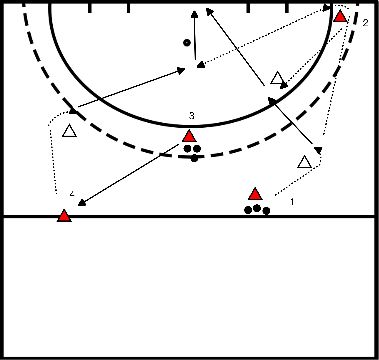Hockey drills for technique passing
- A gives a hard pass to B
- B slaloms between pawns with the ball A slaloms between pawns WITHOUT the ball
- B gives a hard pass at the end towards A who takes the ball in the run
- A aligns the ball and finishes with the backhand on goal
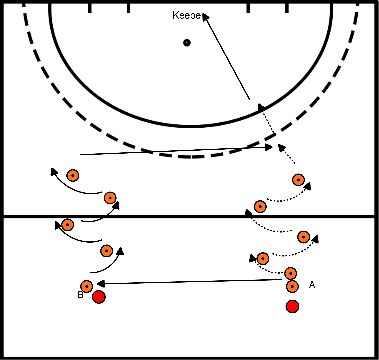
- A pushes the ball to B
- B takes the ball and passes (2 touch)
- B pushes the ball through to C who takes the ball closed
- Who then turns left or right and finishes on goal
- Same on the other side
- You stay with B and A once
- First you give the ball and then you receive the ball and then you pass through
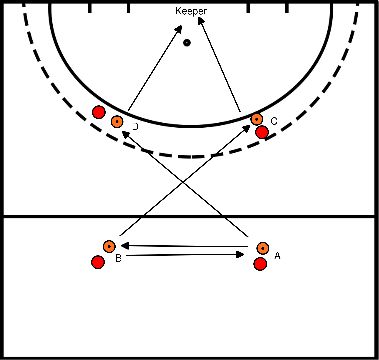
- aim pass at each other's forehand
- run to the ball you passed
- shoot at goal
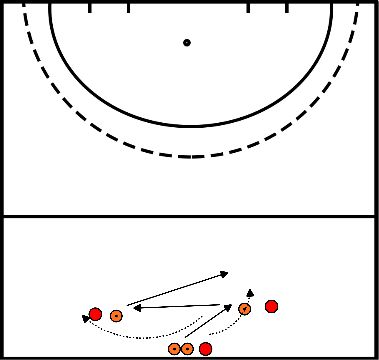
- Exercise with different lift passes.
- A runs to the bar and passes over the bar and gives a pass to B.
- B runs towards the ball and gives a lift pass to A.
- A has gone through to take the ball from B.
- A gives a hard flat towards C.
- C comes in front of the bar and lifts the ball in a movement over the beam bar accelerates towards the circle.
- C ball on the stick enters the circle.
- Aligning ball and shooting at goal
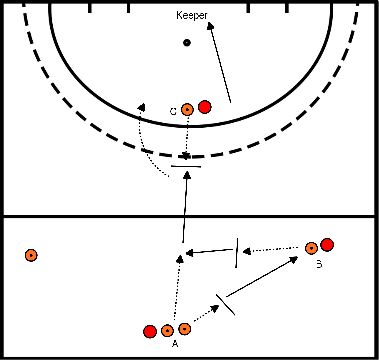
- Player 1 plays ball on player 2.
- player a runs on and receives the ball back, player 1 now plays ball on player 3 and receives the ball back again and shoots the ball at goal.
- variation:
- instead of shot on goal,
- gives player 1 a pass for the goal on player 4
- player 1 takes the place of player 4.
- player 2 and 3 remain.
The pass to the right goes diagonally forward and over the backhand side of the defender, the pass to the left you play wide and goes over the forehand side of the defender.
Therefore the pass to the right is preferred over the pass to the left.
- This is a basic exercise in preparation.
- Just like a tennis player who prepares for training with basic strokes, the players must prepare for the complex training and competition forms, with direct simple passes on top of each other.
- In this way, the trainer has the ability to see technical errors in each individual player and correct them as early as the basic exercise.
- The players pass the ball directly between two pylons and walk counter-clockwise to the other side.
- The size of the target and the distance between the players will be adjusted according to the age and level of the players.
- Two solving exercises that you can both do for 10 minutes
- Also first the explanation of the tip-in exercise
- B starts running around the pilons and accelerates when he reaches the goal towards A.
- A gives a hard facing pass towards the goal
- B tip the ball so that it changes direction
- Then they change places
- Other exercise
- We are going to practice walking in out
- A is a right behind who wants to play the ball somewhere. B is the middle right and he is going to run one in out.
- He starts in the middle of the field and wants to offer himself for A.
- He accelerates towards the sideline A may choose whether he wants to give the ball or not.
- If he doesn't give the ball, A finishes his line further and comes back to where he started and then runs again on another in-out.
- If A passes, B takes the ball and is allowed to score on the goaltender.
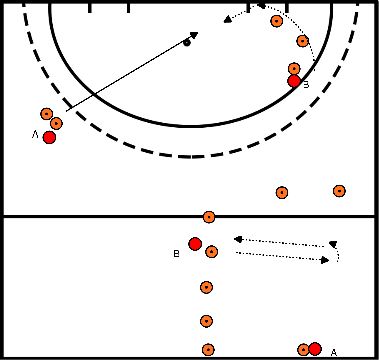
- Exercise expand on both sides
- A gives a push to B
- B takes the ball closed because defender D is in his back.
- B accelerates dribbling with the ball on the stick along the pilons, D runs with B because he doesn't want B to go along.
- D may try to conquer the ball when B has passed the pilons.
- B wants to pass the ball to C. If D intercepts, he passes the ball to C so that the person can continue with the exercise.
- If B gets the ball to C, C will do the same and the defender E will defend. If E picks up the ball, he can finish at the goal.
- How to continue, A goes to the spot of B, B goes to the spot of D, D goes to the spot of C, C goes to the spot of E and E goes to the spot of A.
- Tips for the attackers
- Keep the ball close to you and screen it with your stick
- Pass the ball over the backhand side of your opponent
- Accelerate to make it harder for the defender to stop you
- Tips for the defenders
- Keep your stick on the ground, you can react much faster to what your opponent is doing
- Keep your opponent on the forehand and make sure the line is closed!
- Let the attacker make the mistake and then grab the pass.
- Guide your opponent in the direction where you want him/her to go
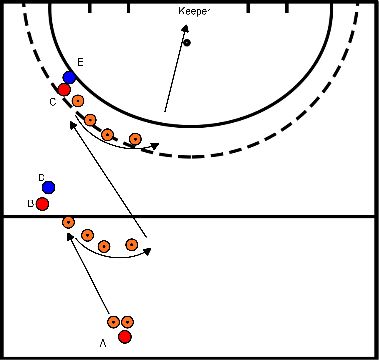
- Exercise expand on both sides.
- A and B start running at the same time,
- A dribbles with the ball on the stick around the pilon.
- B runs in and asks A for the ball.
- A makes eye contact and pushes the ball to B
- B controls the ball closed
- Then dribbles the bars and do two elevator actions over the bars
- Aligns the ball and finishes with a hit on goal.
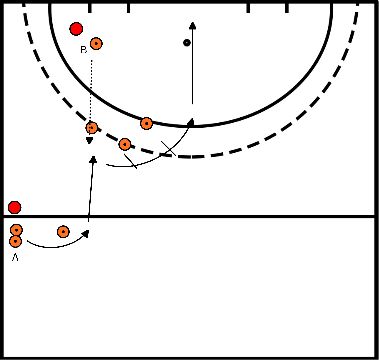
- Players outside the box should replay as often as possible.
- The pass must always pass through the box.
- The players inside the box must try to intercept the ball.
- As soon as the players inside the box have intercepted the ball, they should replay as often as possible inside the box.
- Each time they have replayed 3 times, someone outside the box may enter the box to recapture the ball.
- As soon as they succeed, they will play to someone outside the box and it will start over again, so at least one player must always remain outside the box to be able to play.
- The field can be larger or smaller, there can be more or less players inside and outside the box.
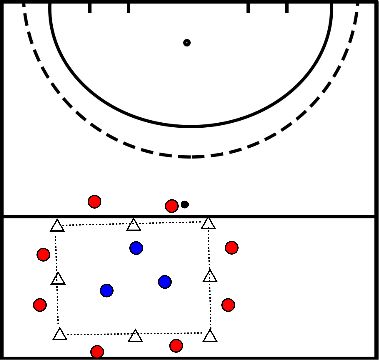
- Player 1 runs with the ball to the white pilon, player 2 runs without the ball to the white pilon.
- Player 2 rounds off on goal (with backhand).
- Player 1 runs around the pilon where player 2 started and runs to the center of the circle.
- As soon as player 1 has played the ball to player 2, player 3 may start. Player 3 plays the ball to player 4.
- Player 4 runs around the white pilon and plays the ball (with backhand) to player 1 who has run into the circle.
